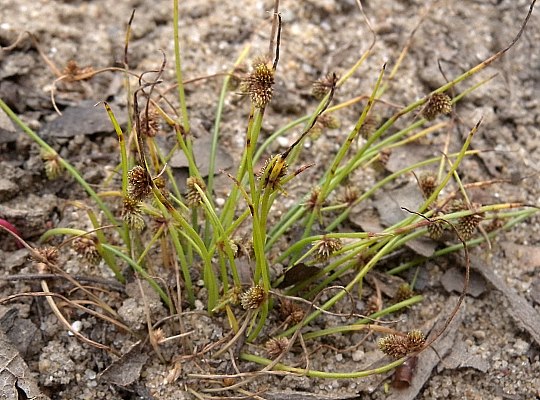
Each culm terminates in an inflorescence consisting of 1-3 spikelets and 1-2 leafy bracts. The spikelets are up to 3 mm. (1/8") long and a little less across; they are ovoid to ovoid-globoid in shape and sessile. Each spikelet consists of numerous perfect florets and their scales, which are arranged in several tiers. Each floret consists of an ovary with a divided style and a single stamen; there are neither petals nor sepals. The outer scale of each floret is 0.5-1.0 mm. in length and elliptic to obovate in shape, tapering to a narrow point; it has a green central vein and membranous margins. There is also a hidden inner scale that is adjacent to the floret; it is about 0.1-0.2 mm. in length and membranous. Sometimes the inner scale is absent. Immature spikelets are light green, while mature spikelets are dark brown. There is an erect leafy bract up to 2" long that resembles an extension of the culm; there is usually a 2nd lateral bract that is shorter. The blooming period can occur from mid-summer into the fall. The florets are wind-pollinated. The florets are replaced by tiny achenes about 0.5 mm. long that are light brown, oblanceoloid in shape, and minutely reticulated. The achenes are without bristles; they are distributed by wind and water. The root system consists of a dense tuft of fibrous roots. This annual plant spreads by reseeding itself.
Cultivation: The preference is full sun, moist conditions, and very sandy soil where there is sparse ground vegetation.

Range & Habitat: The native Dwarf Bulrush is uncommon in the northern half of Illinois, while in the southern half of the state it is rare or absent (see Distribution Map). Because of its small size, this plant may be more common than official records indicate. Habitats include sandy banks along rivers, river sandbars, and sandy shorelines along ponds. Dwarf Bulrush typically establishes itself in these habitats during the summer after spring floodwaters have receded.
Faunal Associations: Because of its small size, Dwarf Bulrush is at best a minor source of food to wildlife. Like the closely related bulrushes (Scirpus spp.), the small seedheads may be consumed by ducks, rails, coots, and other shore birds. The tiny seeds can cling to the feathers and muddy feet of these birds, thereby spreading them to other wetlands. Some insects are known to feed on various parts of bulrushes. These species include leafhoppers (Limotettix spp.), seed bugs (Cymus spp.), the plant bug Teratocoris discolor, leaf beetles (Donacia spp., Plateumaris spp.), and the larvae of Elachista madarella and other moths.
Photographic Location: A sandbar of the Embarras River at Fox Ridge State Park in Coles County, Illinois.
Comments: Other scientific names of Dwarf Bulrush are Scirpus micranthus and Lipocarpha micrantha; different authorities don't always agree on the classification of this plant. Other common names for this plant include Small-Flowered Rush and Smallflower Halfchaff Sedge. Because of its diminutive size, it is very easy to overlook. Dwarf Bulrush is very similar in appearance to another species in its genus, Hemicarpha drummondii (Drummond's Dwarf Bulrush). This latter plant differs by having: 1) spikelets with appressed scales, rather than spreading scales, and 2) scales that are more broad in shape (obovate-orbicular). Drummond's Dwarf Bulrush has been found only in NE Illinois, where it is rare. Both of these species differ from other bulrushes (Scirpus spp.) by having minute internal scales in their spikelets.